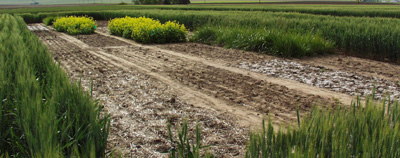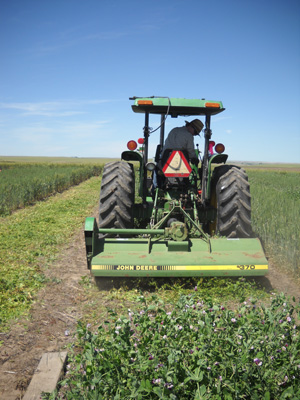Soil Chemistry
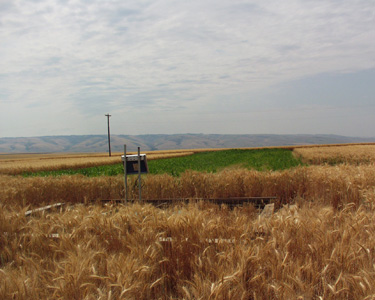
The soil chemistry program is focused on interactions between soil, water, plant and atmosphere. The overall goal of this program is to improve our understanding of biogeochemical processes and anthropogenic environmental change. Our main objectives are: 1) assess impacts of agricultural practices on carbon (C) and nitrogen (N) cycling in agroecosystems, and 2) develop management practices to improve soil C accretion, N and water use efficiency, soil structure, and reduce plant nutrient losses and greenhouse gas emissions.
The research leads to advanced concepts of organic C and N transformation, C accretion or sequestration in soil aggregates, and their effect on surface soil physical properties. Results are expected to produce a series of additions and modifications to the knowledge of C and N dynamics in dryland cropping systems and improve models predicting biogeochemical processes within agroecosystems nationwide.
Associated Personnel:
- Hero Gollany, Research Soil Scientist (Soil Chemistry)
- Wayne Polumsky, Physical Science Technician
- Avery Cook, Biological Science Technician
Collaborators:
- ARS-CPCRC, Pendleton, OR
- Ron Follett (Retired), USDA-ARS-SPNR, Fort Collins, CO
- Stephen DelGrosso, USDA-ARS-SPNR, Fort Collins, CO
- William Pan, Washington State University, Pullman, WA
- David Huggins, USDA-ARS-LMWCR, Pullman, WA
- Ann Kennedy, USDA-ARS- LMWCR, Pullman, WA
- Jay Halvorson, USDA-ARS-NGPRL, Mandan, ND
- Jeff Novak, USDA-ARS-CPRC, Florence, SC
- Steven Machado, Oregon State University, Pendleton, OR
- Michel Cavigelli, USDA-ARS-SASL, Beltsville, MD
- Upendra Sainju, USDA-ARS-ASRU, Sidney, MT
- Luiz Leite, Embrapa Mid-North, Teresina, Brazil
- Paulino Boas, Embrapa Instrumentation, São Carlos, Brazil
- Beata Madari, Embrapa Rice and Beans Research Center, Goiás, Brazil
- Rahmah Dewi Yustika, Indonesian Soil Research Institute, Bogor, Indonesia
Note: For details and downloadable publications related to these projects, see Hero Gollany.
Associated Projects:
GRACEnet (Greenhouse Gas Reduction through Agriculture Carbon Enhancement network)
This project is a cross-location project that includes 32 ARS sites across the USA. The objectives of this project are: 1) evaluate soil carbon status and direction of change of soil C in existing typical and alternative farming systems, and 2) determine net greenhouse gas emissions (CO2, CH4 and N2O) in existing typical and alternative agricultural systems.
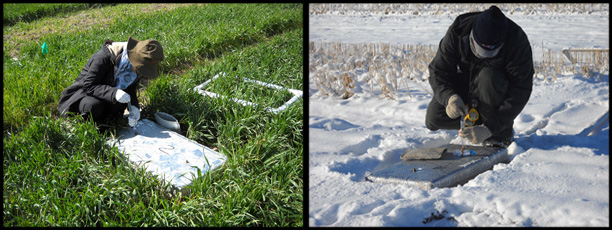
Collecting samples of the soil atmosphere. Greenhouse gas emissions are monitored year-round in the GRACEnet plots.
Our approach involves field-scale measurements of soil C and greenhouse gases using vented static chambers in a conventional winter wheat-summer fallow rotation and alternative management practices (continuous winter wheat, wheat-pea and winter wheat-winter wheat-sudan grass rotations with direct seeding) intended to increase soil organic matter and associated soil organic carbon.
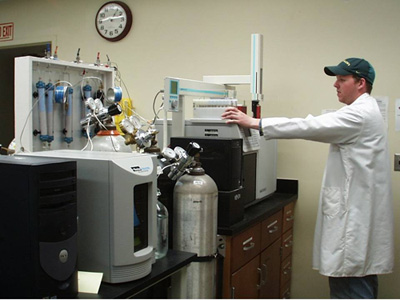
Back in the lab, soil gas samples are analyzed with Gas Chromatography.
CQESTR: Process-based soil carbon model
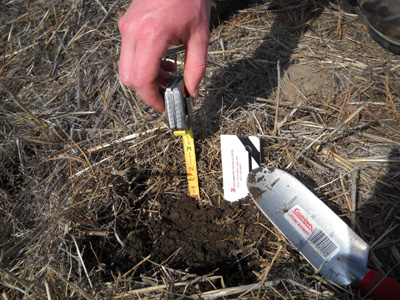
Soil carbon (C) models are important tools for examining complex interactions between climate, crop and soil management practices, and to evaluate the long-term effects of management practices on C-storage potential in soils. The CQESTR, pronounced "Sequester", model was developed to evaluate changes in soil organic matter (SOM) at the field scale, and was initially calibrated in the Pacific Northwest. We have modified and calibrated the model for use across North America. A major modification was to quantify soil texture and drainage effects using calibration datasets with a wide range of soil properties. Secondly, the terminating point for organic residue decomposition and residue-to-SOM transfer was changed from calendar-based time to growing degree-days (thermal time). A third modification of CQESTR was to separate the surface residue into two compartments, each with a different water coefficient. This was based on the non-uniform decomposition of accumulated surface residue in a no-tillage cropping system as a result of annual residue layering. A fourth modification involved the inclusion of partially decomposed residue with stable simulated SOM when comparing with SOM observations, since SOM determination unavoidably includes some partially decomposed residue. Finally, a soil organic carbon capacity algorithm was added to account for carbon saturation in some soils due to changes in management practices. The current version of the CQESTR model (v. 2.0) was validated with SOM databases from various regions of North and South America, Indonesia, Italy and Africa.
Resilient Economic Agricultural Production (REAP)
This is a multi-unit, cross-location project. The objectives of this project are: 1) determine the amount of crop residue that must remain on the land to maintain soil organic carbon and sustain production, and 2) develop algorithms to guide the amount of crop residue that can be sustainably harvested for biomass and bio-based products without degrading the soil resource, environmental quality, or productivity. Our approach involves using measurements taken in plots with residue either removed or returned at different rates (from across North America) and applying the CQESTR model to predict how much crop residue can be sustainably harvested while maintaining soil organic carbon.
Long-term No-tillage and Conventional tillage experiments
The long-term direct seed or no-tillage A (NTA) experiment was established in 1982, and the NTB and the conventional moldboard tillage (CT) experiments were added in 1997. The NTA and NTB consist of five N treatments (0, 40, 80, 120, and 160 lb N/acre) and four replications, in a winter wheat-fallow rotation with each phase of the rotation represented each year. The CT plots are four replications of two N rates (0 and 120 lb/ac). A cover crop of Austrian pea replaced the fallow phase in the rotation in the NTB experiment in 2010. The objectives are: 1) assess soil carbon and nitrogen (N) status and direction of change in presence of cover crop, and 2) determine net greenhouse gas emissions (CO2, CH4 and N2O), and 3) evaluate changes in microbial community structure and diversity with N fixing legume, 4) determine changes in N and water use efficiency, and 5) effect of NT and CT on soft white wheat grain nutritional characteristics.
In-season Nitrogen Fertilization
A continuous winter wheat under direct seeding (NT) experiment was established in 1997 and became a part of the GRACEnet project in 2003. In 2011 the plots were divided into three subplots with starter fertilizer added during seeding and additional N fertilizer added at rates of 0, 50 and 100 lb/ac to subplots at mid-season. The objectives of this study are to: 1) assess winter wheat yield response to in-season N fertilizer application, and 2) determine net greenhouse gas (CO2, CH4 and N2O) emissions and reductions in N2O emission due to alternative N application practices.
Carbon source quality influence on soil properties
This research will provide a process-based understanding of how the quality of different organic residue sources and the plant affect soil chemical, biological and physical properties. A small plot experiment was set up with two main treatments (continuous winter wheat, and continuous fallow) and a variety of carbon sources having specific chemical properties applied annually to the surface soil of individual plots for five years. Treatments included wood (lignin), wheat straw, sucrose, cotton (cellulose), alfalfa pellets (high amino N), manure, municipal biosolids (humic substance), composted wheat residue, perennial grass, winter brassica residue, winter brassica crops, and a check (no addition). The objectives are: 1) evaluate soil carbon (C) status and direction of change of soil C in the presence of source C materials, and 2) determine if quality of organic material entering the soil is more important than the quantity of organic matter in stabilizing soil aggregates. Temporal dynamics of soil organic C and soil aggregates and their stability are determined, and their correlation to different C sources will be developed.
